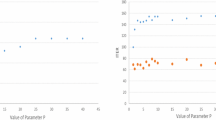Abstract
We show that the Cottle—Dantzig generalized linear complementarity problem (GLCP) is equivalent to a nonlinear complementarity problem (NLCP), a piecewise linear system of equations (PLS), a multiple objective programming problem (MOP), and a variational inequalities problem (VIP). On the basis of these equivalences, we provide an algorithm for solving problem GLCP.
Similar content being viewed by others
Explore related subjects
Discover the latest articles and news from researchers in related subjects, suggested using machine learning.References
H.P. Benson, “Existence of efficient solutions for vector maximization problems,”Journal of Optimization Theory and Applications 26 (1978) 559–580.
R. Chandrasekaran, “A special case of the complementary pivot problem,”Opsearch 7 (1970) 263–268.
R.W. Cottle and G.B. Dantzig, “A generalization of the linear complementarity problem,”Journal of Combinatorial Theory 8 (1970) 79–90.
R.W. Cottle, J. Pang and R.E. Stone,The Linear Complementarity Problem (Academic Press, New York, 1992).
B.C. Eaves and C.E. Lemke, “Equivalence of LCP and PLS,”Mathematics of Operations Research 6 (4) (1981) 475–484.
B.C. Eaves and H. Scarf, “The solutions of systems of piecewise linear systems,”Mathematics of Operations Research 1 (1975) 1–27.
A.A. Ebiefung and M.M. Kostreva, “Global solvability of generalized linear complementarity problems and a related class of polynomial complementarity problems,” in: C. Floudas and P. Pardalos, eds.,Recent Advances in Global Optimization (Princeton University Press, Princeton, NJ, 1992) pp. 102–124.
M. Fiedler and V. Pták, “On matrices with non-positive off-diagonal elements and positive principal minors,”Czechoslovak Mathematical Journal 12 (1962) 382–400.
G.J. Habetler and M.M. Kostreva, “On direct algorithms for nonlinear complementarity problems,”SIAM Journal on Control and Optimization 16 (1978) 504–511.
S. Karamardian, “The complementarity problem,”Mathematical Programming 2 (1972) 107–129.
M.M. Kostreva and M.M. Wiecek, “Linear complementarity problems and multiple objective programming,”Mathematical Programming 60 (1993) 349–359.
O.L. Mangasarian, “Generalized linear complementarity problems as linear programs,”Operations Research Verfahren 31 (1979) 393–402.
J. Moré, “Coercivity conditions in nonlinear complementarity problems,”SIAM Review 1 (16) (1974) 1–16.
J. Moré and W. Rheinboldt, “On P-and S-functions and related classes of nonlinear mappings,”Linear Algebra and its Applications 6 (1973) 45–68.
K.P. Oh, “The formation of the mixed lubrication problem as generalized nonlinear complementarity problem,”Transactions of ASME. Journal of Tribology 1 (8) (1986) 598–604.
P.M. Pardalos, “Parallel search algorithms in global optimization,”Applied Mathematics and Computation 29 (1989) 219–229.
P.M. Pardalos and J.B. Rosen, “Global optimization approach to the linear complementarity problem,”SIAM Journal on Scientific and Statistical Computing 9 (1988) 341–353.
M. Sun, “Monotonicity of Mangasarian's iterative algorithm for the generalized linear complementarity problem,”Journal of Mathematical Analysis and Applications 144 (1989) 474–485.
B.P. Szanc, “The generalized complementarity problem,” Ph.D. Thesis, Rensselaer Polytechnic Institute, Troy, NY, 1989.
A. Tamir, “Minimality and complementarity properties associated with Z-functions and M-functions,”Mathematical Programming 7 (1974) 17–31.
L. Vandenberghe, B.L. DeMoor and J. Vanderwalle, “The generalized linear complementarity problem applied to the complete analysis of resistive piecewise-linear circuits,”IEEE Transactions on Circuits and Systems 11 (1989) 1382–1391.
A. Villar,Operator Theorems with Applications to Distributive Problems and Equilibrium Models (Springer, New York, 1992).
Author information
Authors and Affiliations
Additional information
Project partially supported by a grant from Oak Ridge Associated Universities, TN, USA.
Rights and permissions
About this article
Cite this article
Ebiefung, A. Nonlinear mappings associated with the generalized linear complementarity problem. Mathematical Programming 69, 255–268 (1995). https://doi.org/10.1007/BF01585560
Received:
Revised:
Issue Date:
DOI: https://doi.org/10.1007/BF01585560



